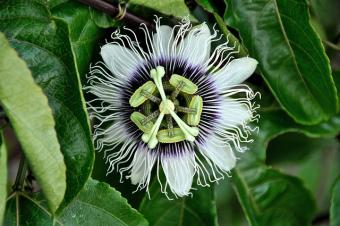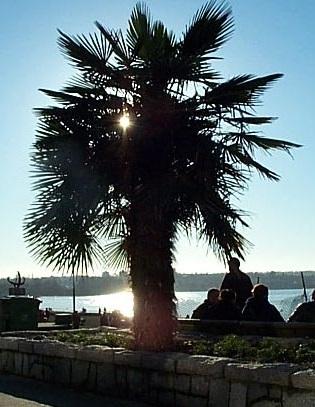
pixabay used under license; https://pixabay.com/en/swimming-pool-pyrenees-france-243598/ pool
Poolside landscaping is an opportunity to create a soothing oasis in your backyard. If you've invested in installing a pool, go the extra step and choose plants that are truly complementary.
Characteristics of Good Poolside Plants
There are several important characteristics to look for when choosing plants for around your pool, some of which are practical, some of which are aesthetic. The aesthetic part is easy to imagine, just think of a tropical oasis -- gently swaying palm trees, lush foliage, and exotic flowers. To avoid unwanted maintenance and safety issues, however, make sure the plants also meet the following requirements.
- Minimal litter - Cleaning sticks and leaves from the pool and constantly sweeping up the poolside patio is big chore; plus, you don't want people running barefoot over tree litter.
- Doesn't attract swarms of bees - The good news is that most tropical flowers are not particularly attractive to bees; but avoid things with clusters of small blue or purple flowers, like lavender and rosemary, which are extremely appealing to bees.
Exotic Flowers
The following species are a good choice to plant in masses near the edge of the poolside patio where they can be enjoyed up close. They can also be planted in pots and planters directly on the patio.
Bird of Paradise

pixabay used under license; https://pixabay.com/en/bird-of-paradise-flower-bloom-599169/ strelitzia flower
Bird of paradise (Strelitzia reginae) has large paddle-shaped leaves and multi-colored blossoms that resemble the head of a tropical bird. Those features, plus the fact that it makes virtually no litter, make it a very popular poolside plant. It grows as an evergreen perennial to about 4 feet tall and is hardy in USDA zones 9 to 11.
This species has high water requirements, but needs little other care besides clipping off the flower stalks as they fade. Occasional fertilization with a balanced, all-purpose fertilizer will promote lush growth and abundant flowering. Grow bird of paradise in full sun, planting it in a pot and moving it indoors for the winter in cold climates.
Passion Flower Vines

pixabay used under license; https://pixabay.com/en/passiflora-flowers-nature-passion-588757/ passion flower
Passion vines (Passiflora spp.) produce some of the most ornate and exotic-looking flowers of any vine species. With their lush foliage and lack of leaf litter, they are ideal to cover a poolside pergola or fence. The vines grow to 20 feet or more and come in a variety of colors, including purple, blue, red, pink, orange and white. Some species also produce a fruit that is used to flavor tropical beverages.
Most passion vine species are hardy only to zone 8 or 9 , though one species, known as the maypop (P. incarnata), is hardy in USDA zones 5 to 9. All passion vines need full sun and a support structure to grow on. They have minimal maintenance requirements other than regular watering.
Canna Lily

pixabay used uinder license; https://pixabay.com/en/canna-keli-canna-lily-flower-333363/ canna flower
Canna lilies (Canna spp.) are known for their bright blossoms in summer that come in an array of warm colors. They have lush oval-shaped foliage and produce virtually no litter. Cannas grow from tuberous roots to about 4 or 5 feet tall and and hardy in USDA zones 7 to 10. In colder zones the tubers can be dug up and stored indoors for winter.
Cannas need full sun and flower best with regular water and rich soil. The only maintenance needed is to cut the stalks to the ground after the first frost in fall.
Lush Foliage
These species balance the color of the tropical flowers with the cool, soothing feel of large, deep green leaves. Use them as a green backdrop behind the flowers.
Elephant Ear

pixabay used under license; https://pixabay.com/en/elephant-ears-ferns-tropical-plants-417808/ colocasia
Elephant ear (Colocasia spp.) is a tuberous perennial with heart-shaped leaves up to 2 feet long that rise on slender stalks several feet above the ground. It is an extraordinarily neat and tidy plant and creates a primordial jungle-like feel around a pool. They are quite shade tolerant, but will grow in full sun, as well, especially in mild climates. They are hardy in USDA zones 7 to 11, though the tubers can be dug up and stored indoors for winter in colder zones.
Elephants ear is easy to grow in rich, moist soil -- they can even be used in water gardens. No maintenance is needed other than cutting the stalks to the ground after the first frost in fall.
Tasmanian Tree Ferns

pixabay used under license; https://pixabay.com/en/fern-green-plant-nature-spring-71991/ tree fern
Any type of fern lends a lush look to shady areas within poolside plantings, but the Tasmanian tree fern (Dicksonia antartica) is the most impressive of them all. It develops a fibrous trunk and can eventually grow to 10 feet or more in height with individual fronds measuring 6 feet or more in length. Tasmanian tree ferns are hardy in USDA zones 9 to 11, but can be grown in a large tub and brought indoors for winter in colder climates.
The only maintenance necessary is to occasionally clip off dead fronds. Tasmanian tree ferns grow best with partial shade, rich soil and frequent irrigation.
Aucuba

MF|Morguefile used under license; http://www.morguefile.com/archive/display/193031 aucuba
Aucuba (Aucuba japonica) is an evergreen shrub that is one of the best choices where a hedge is desired around a poolside planting. It has large oval-shaped leaves in a deep green color flecked with yellow. Most varieties grow about head-high, but they take almost any degree of pruning. Hardy in USDA zones 6 to 10, aucuba is very shade tolerant, but will take full sun in mild climates.
Unlike many plants with lush foliage, aucuba has very low irrigation and fertility requirements. It is completely maintenance free unless you want to prune it for shape or to control its size.
Aucuba only produce berries if both male and female varieties are planted. If they're planted where they will hang over a pool patio, plant just one variety or make sure they are all male. 'Mr. Goldstrike' is a common male variety.
Palms
For the most part, trees are not recommended for poolside areas. Even evergreen species lose all of their leaves on an annual basis (they just don't go bare all at once like deciduous species), making for a big maintenance issue. There is also the danger of tree roots cracking the pavement of a poolside patio.
Palm trees are the one exception, however. They have short fibrous roots and very little litter. Plant them as accents amid swaths of foliage plants.
Royal Palm

pixabay used under license; https://pixabay.com/en/royal-palm-palm-roystonea-regia-293092/ royal palm
Royal palms (Roystonea spp.) are among the largest, most stately palm trees. With their long arching fronds and smooth trunk, they have a quintessential tropical look, making them a very popular poolside plant. Royal palms can eventually grow more than 50 feet tall and are hardy in USDA zones 10 and 11.
Royal palms grow slowly, but they are very adaptable in terms of soil type and frequency of irrigation. Unfortunately they are prone to a number of pests and diseases, such as the royal palm bug and ganoderma butt rot, a fatal palm tree disease. The only maintenance required is to remove the fronds as they fade -- though because of their size, this requires the help of a professional arborist.
Windmill Palm

freeimages.com used under license; http://www.freeimages.com/photo/273243 windmill palm
For a smaller, more cold hardy palm, consider windmill palms (Trachycarpus fortunei). This type of palm is hardy in USDA zones 8 to 11 and grows to just 10 or 20 feet in height. The leaves are fan-like and the trunk has a rough, hairy texture. They are small enough to be grown in a large tub and brought indoors for winter.
Windmill palms grow best in partial shade, but can tolerate full sun in mild climates. They are very adaptable to soil type as long as it is well-drained, but perform best with regular irrigation. The only maintenance needed is to remove the dead fronds periodically.
Poolside Paradise
A backyard pool is not complete without a fitting landscape. Rather than landscape it as you would any other part of the yard, consider the practical needs of a poolside area and choose from plants that accentuate the relaxing feeling of your personal paradise.







